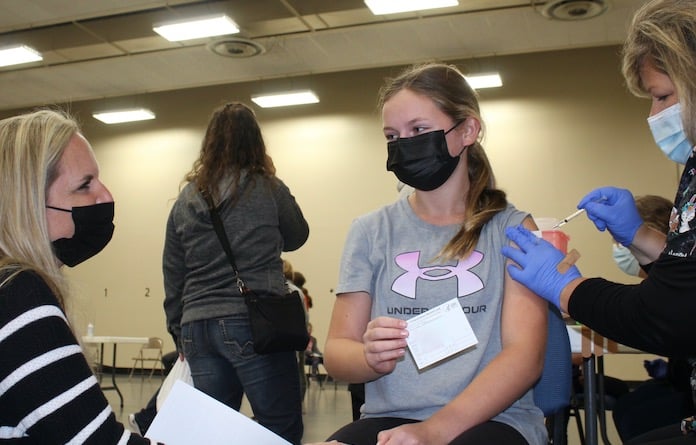Hospitals ‘very full’ amidst new COVID surge

Health care leaders are warning this COVID-19 surge is shaping up to be like that of Christmas past, but it is becoming evident hospitals are starting to field some unique challenges.
Just as in Illinois, St. Louis-area hospitals are seeing a decrease in hospital bed availability. As of Thursday, 10 percent of the patients in the hospitals that comprise BJC HealthCare had COVID-19, and 25 percent of all ICU patients had the disease.
“That’s a big chunk of our capacity being used for that one disease condition, and the other things aren’t stopping, so that’s a sizable impact,” said Dr. Clay Dunagan, BJC’s Chief Clinical Officer and an infectious disease specialist with Washington University.
Dunagan said the volume of hospitalizations due to COVID this area is experiencing is on track to hit that seen with the Delta variant.
“The case rates, the number of people reported (that have COVID-19), has passed the last surge. So that’s on its way up to be the second biggest surge we’ve had,” Dunagan said. “In terms of the hospitals, we are two-thirds of the way back up to the peak we saw in September and October (with) the first Delta wave … and we’ll quickly get all the way back up to that certainly in December.”
Monroe County is now seeing first hand these climbing case numbers and hospitalizations.
As of Tuesday, Monroe County Health Department Administrator John Wagner reported 218 active coronavirus cases, 12 of which are hospitalized.
Monroe County’s most recently counted COVID-related death, a man in his early 60s who brought the death toll to 106, had been hospitalized due to the virus, Wagner said.
Because Monroe County does not have a hospital, many of its residents go across the river to seek urgent medical care.
St. Louis hospitals are gearing up for even more struggles. As of press time, there is one documented case of the Omicron variant in St. Louis. Dunagan said it has not yet been found in any other Missouri samples, nor in wastewater sampling.
“So, we don’t have any suggestion that Omicron is playing a role in this, but the speed of the run-up has at least raised the issue,” Dunagan concluded. “The question for me is whether Omicron is already here and playing a role. If it’s not, it is undoubtedly going to arrive and that will put further pressure on transmission in the region.”
Wagner echoed Dunagan’s sentiment for Monroe County: If the Omicron variant is not already playing a role in increasing COVID numbers, he said it soon will.
Dunagan noted the surge St. Louis is experiencing is not unique to this region, and much of the Upper Midwest is seeing increased numbers.
While Dunagan said health care has learned how to decrease mortality rates from previous surges through medicine, there are several challenges aside from the new variant that hospitals are facing in this particular surge.
Staffing shortages have progressively gotten worse as the pandemic continues, with it now having a direct impact on hospitals’ capacity limits.
“COVID itself has accelerated retirements from health care; it has encouraged some people to move out of the really challenging inpatient care setting into other settings where COVID is not really a big impact,” Dunagan said. “It’s also pushed us to use agency nursing, which is really expensive compared to what normal operations would be. Even agency nursing is harder to come by at this point.”
Contrary to popular belief, the number of BJC employees who left the field for not complying with vaccine mandates has “had very little impact on (BJC’s) workforce.”
Yet, there might be another politicized factor that plays into the staffing shortage.
“The political divide is also having an effect on (burn out) because there is some hostility among patients and families toward health care because of this mistaken belief that somehow this is a manufactured crisis,” Dunagan said. “I think whereas in the early (pandemic period) health care workers were celebrated as heroes, there are some people who are looking at health care workers as the enemy and I think that is incredibly discouraging to clinicians who are sacrificing and risking a lot to take care of people.”
Since the staffing shortage is causing capacity to dwindle, BJC hospitals are having to take a critical look at what patient transfers to accept as well as what services to offer.
Should this get worse, there can be serious consequences.
“While we talk in terms of elective procedures, even elective procedures have a timeframe,” Dunagan said. “So, doing a colon resection for colon cancer, yes that can be postponed, but the longer you postpone it, the greater the risk that it may spread. It’s not like there’s no consequence to postponing these cases, so I think there’s a real risk that this will start to impair the care of other patients.”
In the relatively early days of this new surge, emergency rooms in the region are already “very full.”
“I think between flu and COVID, we’ll continue to see the emergency room struggle,” Dunagan said, noting flu season is shaping up to be aggressive. “That may pose a threat to someone who has a heart attack or a stroke trying to get into an emergency room. We will do our best always to take care of patients who are critically ill, but there’s no question that when the emergency room is overrun with patients that it can be very challenging to do things the way we would like to.”
Because of this, Dunagan said those who are needing more minor medical attention, such as needing to get a COVID test, should utilize their primary care physician, urgent care or convenient care over the ER. Yet, those who feel they are experiencing a medical emergency, such as chest pains or a stroke, should go to the ER immediately.
After months of relatively low case counts in Monroe County, one may be wondering how the area is now finding itself battling another surge. Dunagan said there are three main factors contributing to this surge.
“This coronavirus is more and more behaving like other respiratory viruses which always increase in the winter because people move indoors and there are more opportunities for sharing viruses among family members and at work,” Dunagan said.
The second component, he said, is that COVID vaccines were approved for emergency use roughly a year ago. Those who did not wait to get their initial series may be seeing immunity decrease – without a booster dose, of course.
“(For) a number of people, their immunity from that first immunization is starting to wane somewhat so they’re becoming higher risk. Those who have been boosted, I think, are still pretty well protected,” Dunagan explained.
Wagner said anybody needing their booster dose, or even initial series, may do so by scheduling an appointment with the Monroe County Health Department by calling 618-939-3871.
Currrently, 56.30 percent (19,329 residents) of Monroe County are fully vaccinated, which does not include individuals in the ages 5-11 group or booster.
A new phenomena dubbed “COVID fatigue” may also be contributing to this surge, Dunagan said.
“I think we have COVID fatigue in the population,” he said. “People are less willing to wear a mask and socially distance and to cut off on activities. Last year in that surge, I think people were more willing to take those steps to protect themselves and others.”
However tiresome some may find them, these precautions are instrumental in preventing serious illness – especially for those who have not yet gotten a booster shot. Dunagan said receiving a booster dose can reduce the risk of one being hospitalized from COVID by tenfold.
“Even if they are vaccinated, with such a high burden in the population and such high transmission rates, they need to wear a mask, socially distance, have good hand hygiene and avoid gatherings where there will be large numbers of people, especially if that group is going to contain individuals who may not be vaccinated,” he said. “People do have the means to stay pretty safe, but it does require the discipline to take these basic public health measures while getting your immunity set up with a vaccine.”






